Hierarchical Multi-Communities Energy Sharing Management with Electric Vehicle Integration
Abstract
1. Introduction
- A novel energy sharing management model for hierarchical multi-communities energy sharing is proposed. This model incorporates EVs as movable energy storage units capable of charging and discharging in different locations, with two distinct pricing structures: community sharing price and multi-communities sharing price.
- A three-level Stackelberg game is proposed to model the interactions among three key participants: the Utility Company (UC), Community Energy Aggregators (CEAs), and Electric Vehicles (EVs). The framework identifies optimal pricing and energy strategies while ensuring and proving the existence and uniqueness of the Stackelberg equilibrium.
- The three-level optimal energy–price equilibrium (3OEP) algorithm is developed to attain the game equilibrium. It guarantees that no participant can improve their payoff by independently deviating from the equilibrium strategy.
2. Related Works
3. System Model
3.1. Overview Structure
- Electric Vehicle (EV): Each electric vehicle is capable of charging and discharging energy through CEA. We assume that all EVs are equipped with a smart energy management system (SEMS), through which they can communicate with CEA via charging facilities. The SEMS sends consumption data and receives shared price information. It is able to perform necessary computational tasks and control charging and discharging.
- Community Energy Aggregator (CEA): Each CEA facilitates energy sharing within the community by engaging in two-way communication with EVs within its community. It also communicates with UC for the purpose of energy sharing between communities and determines the energy sharing prices within the community. The CEA ensures payment and energy balance for the community in which it sells or buys energy to or from EVs within the community and the utility company. If there is a net surplus of energy within the community, the CEA is responsible for selling the excess energy to the utility company. Similarly, if the generated energy within the community is insufficient, the CEA is responsible for purchasing the energy from the utility company.
- Utility Company (UC): The UC sells or buys energy to or from CEAs at real-time pricing according to the net aggregated energy from the multiple communities.
3.2. Electric Vehicle (EV) Model
3.3. Community Energy Aggregator (CEA) Model
3.4. Utility Company (UC) Model
4. Hieracrchical Stackelberg Game Among Players
4.1. Game Formulation
- (1)
- First loop between the top level and middle levelIn the first loop, the UC takes the role of the leader, seeking to maximize its utility (8) by determining the optimal multi-communities sharing price for the entire system and announcing it to the CEAs. This involves a trade-off between the revenue from selling the generated energy and the cost of producing the energy in the UC’s utility model. The followers in this loop are the CEAs of communities , where each CEA responds to the multi-communities sharing price set by the UC by participating in the second loop game with the EVs. The CEA issues its community energy-sharing price to the EVs within its community, and once the EVs respond with their energy usage, the CEAs calculate the net aggregated community energy for each community and send it back to the UC level. Consequently, the multi-communities sharing price set by UC will influence the total aggregated energy in the system that UC needs to accommodate.
- (2)
- Second loop between the middle level and bottom levelThe second loop is the game between the CEA and its EVs within the community. In this loop, after each CEA receives the multi-communities sharing price from the UC, each CEA m takes on the leader role and determines the optimal community sharing price for its community m to maximize its utility (4). In the CEA’s utility model, there is a trade-off between the revenue/cost from selling/buying energy with EVs inside the community and the payment/revenue from buying/selling the net aggregated community energy with the UC. The EVs within community m, who are the followers, respond to the community sharing price sent by CEA m by adjusting their energy strategy, specifically the amount of charging or discharging energy, to maximize their utility (1). Again, this involves a trade-off between the satisfaction function and the revenue/cost of selling/buying energy with CEA m.
4.2. Existence and Uniqueness of the Equilibrium
4.3. Three-Level Optimal Energy–Price (3OEP) Equilibrium Algorithm
| Algorithm 1: Three-Level Optimal Energy–Price (3OEP) Equilibrium Algorithm |
|
5. Evaluation Studies
5.1. Simulation Setup
5.2. Results and Discussion
- Typical charging [41]: Individuals charge their EVs upon returning home in the evening, following typical human behavior.
- The single-community two-level Stackelberg game (S2LV) [19]: The two-level Stackelberg game is widely utilized in the literature, where it typically considers the interaction between an aggregator or a coordinator and end-users such as prosumers and EVs. However, the literature often overlooks the benefit model of the UC and frequently assumes pricing based on time-of-use (ToU), where the on-peak period is from 9 a.m. to 10 p.m., and the rest of the time is considered off-peak. This approach is commonly found in the literature, where the system is treated as a single community, and a uniform energy-sharing price is applied across all users.
- The multi-communities two-level Stackelberg game (M2LV) [26]: This scheme employs the commonly used two-level model, but extends it to consider multiple communities. In this approach, the energy profile and pricing differ across communities, reflecting a more realistic representation of real-world scenarios. Typically, different types of consumers with varying load profiles are charged different prices, aligning with the unique characteristics and demands of each community.
- Proposed multi-communities three-level optimal energy–price (3OEP) model: The proposed 3OEP model introduces a three-level framework designed to optimize energy allocation and pricing across multiple communities. Unlike traditional two-level models, this approach incorporates an additional layer to address interactions among the utility company (UC), aggregators (AGGs), and end-users, such as electric vehicles (EVs), within distinct communities. The energy profiles and pricing structures vary across communities, reflecting the unique characteristics and demands of their respective load profiles. EVs capable of moving between different communities engage in charging and discharging at various locations, such as residential areas, offices, and shopping malls. The electricity price varies across these locations, and the amount of charging and discharging is determined by the proposed algorithm.
6. Conclusions
Author Contributions
Funding
Data Availability Statement
Acknowledgments
Conflicts of Interest
References
- Muir, A.; Lopatto, J. Final Report on the August 14, 2003 Blackout in the United States and Canada: Causes and Recommendations; U.S. Environmental Protection Agency: Washington, DC, USA, 2004. [Google Scholar]
- Singer, S. The Energy Report: 100% Renewable Energy by 2050; Ecofys B.V.: Utrecht, The Netherlands, 2010. [Google Scholar]
- Zhang, C.; Wu, J.; Zhou, Y.; Cheng, M.; Long, C. Peer-to-Peer energy trading in a Microgrid. Appl. Energy 2018, 220, 1–12. [Google Scholar] [CrossRef]
- Lim, Y.; Javaid, S.; Khwanrit, R.; Tan, Y. Seasonal storage capacity design for distributed power flow system with safe operation conditions. In Proceedings of the 2022 IEEE International Conference on Consumer Electronics—Taiwan, Taipei, Taiwan, 6–8 July 2022; IEEE: New York, NY, USA, 2022; pp. 577–578. [Google Scholar]
- Khwanrit, R.; Lim, Y.; Javaid, S.; Kittipiyakul, S.; Tan, Y. Study of energy loss for distributed power-flow assignment in a smart home environment. Designs 2022, 6, 99. [Google Scholar] [CrossRef]
- Khwanrit, R.; Javaid, S.; Lim, Y.; Charoenlarpnopparut, C.; Tan, Y. Optimal Vehicle-to-Grid Strategies for Energy Sharing Management Using Electric School Buses. Energies 2024, 17, 4182. [Google Scholar] [CrossRef]
- Abrishambaf, O.; Lezama, F.; Faria, P.; Vale, Z. Towards transactive energy systems: An analysis on current trends. Energy Strategy Rev. 2019, 26, 100418. [Google Scholar] [CrossRef]
- Liu, N.; Yu, X.; Wang, C.; Li, C.; Ma, L.; Lei, J. Energy-Sharing Model With Price-Based Demand Response for Microgrids of Peer-to-Peer Prosumers. IEEE Trans. Power Syst. 2017, 32, 3569–3583. [Google Scholar] [CrossRef]
- Liu, N.; Yu, X.; Wang, C.; Wang, J. Energy Sharing Management for Microgrids With PV Prosumers: A Stackelberg Game Approach. IEEE Trans. Ind. Inform. 2017, 13, 1088–1098. [Google Scholar] [CrossRef]
- Paudel, A.; Chaudhari, K.; Long, C.; Gooi, H.B. Peer-to-peer energy trading in a prosumer-based community microgrid: A game-theoretic model. IEEE Trans. Ind. Electron. 2018, 66, 6087–6097. [Google Scholar] [CrossRef]
- Zhang, M.; Eliassen, F.; Taherkordi, A.; Jacobsen, H.A.; Chung, H.M.; Zhang, Y. Demand–response games for peer-to-peer energy trading with the hyperledger blockchain. IEEE Trans. Syst. Man Cybern. Syst. 2021, 52, 19–31. [Google Scholar] [CrossRef]
- Tushar, W.; Saha, T.K.; Yuen, C.; Morstyn, T.; Poor, H.V.; Bean, R.; Nahid-Al-Masood. Grid influenced peer-to-peer energy trading. IEEE Trans. Smart Grid 2019, 11, 1407–1418. [Google Scholar] [CrossRef]
- Kang, J.; Yu, R.; Huang, X.; Maharjan, S.; Zhang, Y.; Hossain, E. Enabling localized peer-to-peer electricity trading among plug-in hybrid electric vehicles using consortium blockchains. IEEE Trans. Ind. Inform. 2017, 13, 3154–3164. [Google Scholar] [CrossRef]
- Kim, J.; Lee, J.; Choi, J.K. Joint demand response and energy trading for electric vehicles in off-grid system. IEEE Access 2020, 8, 130576–130587. [Google Scholar] [CrossRef]
- Aznavi, S.; Fajri, P.; Shadmand, M.B.; Khoshkbar-Sadigh, A. Peer-to-peer operation strategy of PV equipped office buildings and charging stations considering electric vehicle energy pricing. IEEE Trans. Ind. Appl. 2020, 56, 5848–5857. [Google Scholar] [CrossRef]
- Fu, B.; Chen, M.; Fei, Z.; Wu, J.; Xu, X.; Gao, Z.; Wu, Z.; Yang, Y. Research on the stackelberg game method of building micro-grid with electric vehicles. J. Electr. Eng. Technol. 2021, 16, 1637–1649. [Google Scholar] [CrossRef]
- Rui, T.; Hu, C.; Li, G.; Tao, J.; Shen, W. A distributed charging strategy based on day ahead price model for PV-powered electric vehicle charging station. Appl. Soft Comput. 2019, 76, 638–648. [Google Scholar] [CrossRef]
- Bo, W.; Zhang, W.; Du, R.; Wang, D.; Zhao, Y.; Li, Q.; Zhang, Z. Collaborative optimal dispatch of microgrid and electric vehicles based on the Stackelberg game. Front. Energy Res. 2022, 10, 974282. [Google Scholar] [CrossRef]
- Kim, J.; Lee, J.; Park, S.; Choi, J.K. Power scheduling scheme for a charging facility considering the satisfaction of electric vehicle users. IEEE Access 2022, 10, 25153–25164. [Google Scholar] [CrossRef]
- Moret, F.; Pinson, P. Energy collectives: A community and fairness based approach to future electricity markets. IEEE Trans. Power Syst. 2018, 34, 3994–4004. [Google Scholar] [CrossRef]
- Chen, L.; Liu, N.; Wang, J. Peer-to-Peer Energy Sharing in Distribution Networks With Multiple Sharing Regions. IEEE Trans. Ind. Inform. 2020, 16, 6760–6771. [Google Scholar] [CrossRef]
- Wang, Y.; Su, Z.; Xu, Q.; Yang, T.; Zhang, N. A novel charging scheme for electric vehicles with smart communities in vehicular networks. IEEE Trans. Veh. Technol. 2019, 68, 8487–8501. [Google Scholar] [CrossRef]
- Shokouhmand, E.; Ghasemi, A. Stochastic optimal scheduling of electric vehicles charge/discharge modes of operation with the aim of microgrid flexibility and efficiency enhancement. Sustain. Energy Grids Netw. 2022, 32, 100929. [Google Scholar] [CrossRef]
- Zhou, W.; Wu, J.; Zhong, W.; Zhang, H.; Shu, L.; Yu, R. Optimal and elastic energy trading for green microgrids: A two-layer game approach. Mob. Netw. Appl. 2019, 24, 950–961. [Google Scholar] [CrossRef]
- Yu, Y.; Chen, S.; Luo, Z. Residential microgrids energy trading with plug-in electric vehicle battery via stochastic games. IEEE Access 2019, 7, 174507–174516. [Google Scholar] [CrossRef]
- Chen, P.; Han, L.; Xin, G.; Zhang, A.; Ren, H.; Wang, F. Game theory based optimal pricing strategy for V2G participating in demand response. IEEE Trans. Ind. Appl. 2023, 59, 4673–4683. [Google Scholar] [CrossRef]
- Samadi, P.; Mohsenian-Rad, A.H.; Schober, R.; Wong, V.W.S.; Jatskevich, J. Optimal Real-Time Pricing Algorithm Based on Utility Maximization for Smart Grid. In Proceedings of the 2010 First IEEE International Conference on Smart Grid Communications, Gaithersburg, MD, USA, 4–6 October 2010; pp. 415–420. [Google Scholar] [CrossRef]
- Chai, B.; Chen, J.; Yang, Z.; Zhang, Y. Demand Response Management With Multiple Utility Companies: A Two-Level Game Approach. IEEE Trans. Smart Grid 2014, 5, 722–731. [Google Scholar] [CrossRef]
- Mohsenian-Rad, A.H.; Wong, V.W.S.; Jatskevich, J.; Schober, R.; Leon-Garcia, A. Autonomous Demand-Side Management Based on Game-Theoretic Energy Consumption Scheduling for the Future Smart Grid. IEEE Trans. Smart Grid 2010, 1, 320–331. [Google Scholar] [CrossRef]
- Boyd, S.P.; Vandenberghe, L. Convex Optimization; Cambridge University Press: Cambridge, UK, 2004. [Google Scholar]
- Charoen, P.; Sioutis, M.; Javaid, S.; Charoenlarpnopparut, C.; Lim, Y.; Tan, Y. User-centric consumption scheduling and fair billing mechanism in demand-side management. Energies 2019, 12, 156. [Google Scholar] [CrossRef]
- Von Stackelberg, H. Market Structure and Equilibrium; Springer Science & Business Media: Berlin/Heidelberg, Germany, 2010. [Google Scholar]
- PES. IEEE Open Data Sets. Available online: https://site.ieee.org/pes-iss/data-sets (accessed on 12 January 2024).
- Schoettle, B.; Sivak, M. Potential Impact of Self-Driving Vehicles on Household Vehicle Demand and Usage; Technical report; University of Michigan Transportation Research Institute: Ann Arbor, MI, USA, 2015. [Google Scholar]
- Canizes, B.; Soares, J.; Vale, Z.; Corchado, J.M. Optimal distribution grid operation using DLMP-based pricing for electric vehicle charging infrastructure in a smart city. Energies 2019, 12, 686. [Google Scholar] [CrossRef]
- Sousa, T.; Morais, H.; Vale, Z.; Faria, P.; Soares, J. Intelligent energy resource management considering vehicle-to-grid: A simulated annealing approach. IEEE Trans. Smart Grid 2011, 3, 535–542. [Google Scholar] [CrossRef]
- Soares, J.; Sousa, T.; Morais, H.; Vale, Z.; Faria, P. An optimal scheduling problem in distribution networks considering V2G. In Proceedings of the 2011 IEEE Symposium on Computational Intelligence Applications in Smart Grid (CIASG), Paris, France, 1–15 April 2011; IEEE: New York, NY, USA, 2011; pp. 1–8. [Google Scholar]
- Bose, J.; Giesbrecht, L.; Sharp, J. Highlights of the 2001 National Household Travel Survey; Bureau of Transportation Statistics: Washington, DC, USA, 2001. [Google Scholar]
- Long, C.; Wu, J.; Zhou, Y.; Jenkins, N. Peer-to-peer energy sharing through a two-stage aggregated battery control in a community Microgrid. Appl. Energy 2018, 226, 261–276. [Google Scholar] [CrossRef]
- Khwanrit, R.; Lim, Y.; Javaid, S.; Charoenlarpnopparut, C.; Tan, Y. Incorporating a Load-Shifting Algorithm for Optimal Energy Storage Capacity Design in Smart Homes. Designs 2024, 8, 11. [Google Scholar] [CrossRef]
- Kim, D.S.; Chung, Y.M.; Chung, B.J. Statistical Analysis of Electric Vehicle Charging Based on AC Slow Chargers. Energies 2023, 16, 2735. [Google Scholar] [CrossRef]
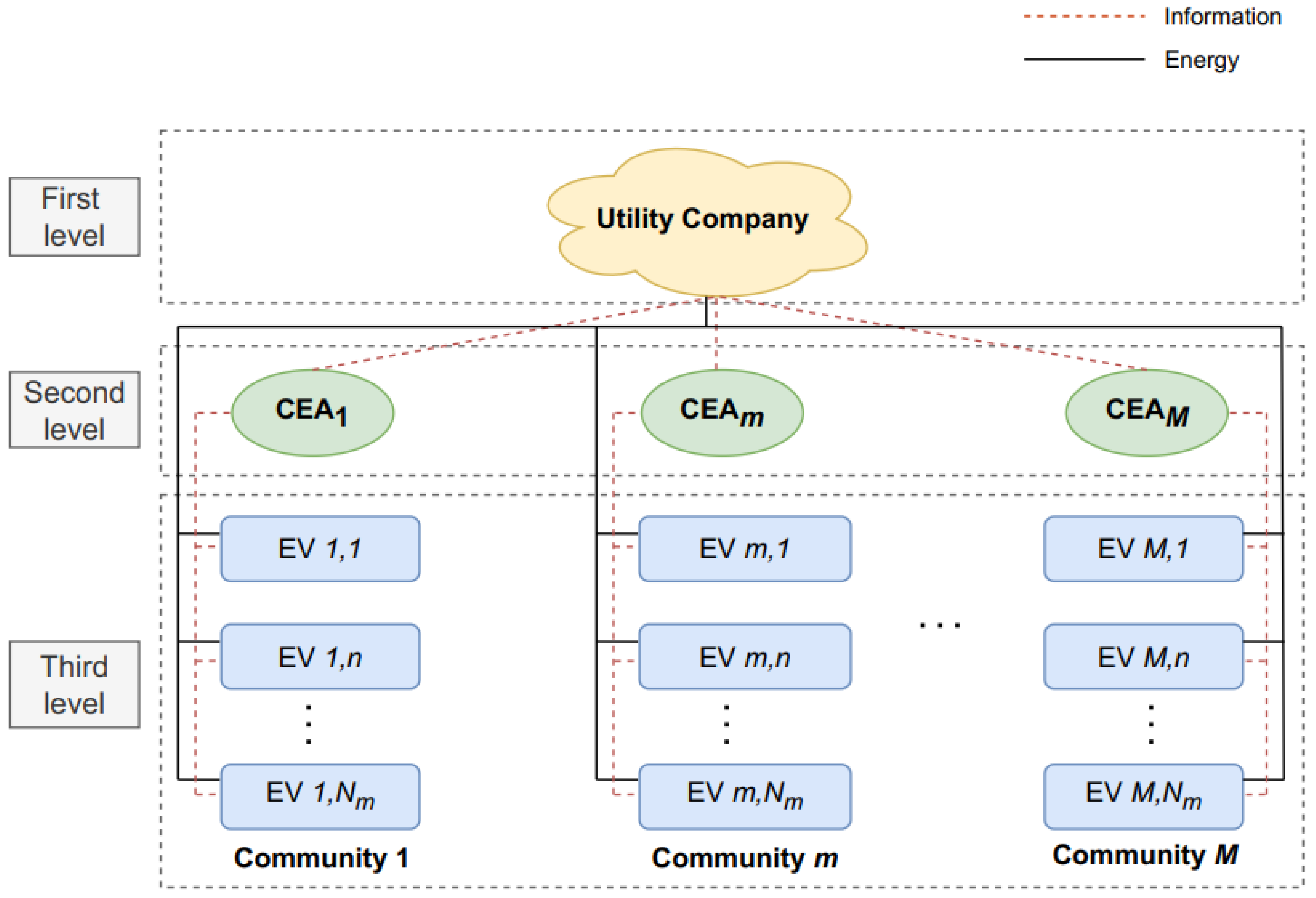


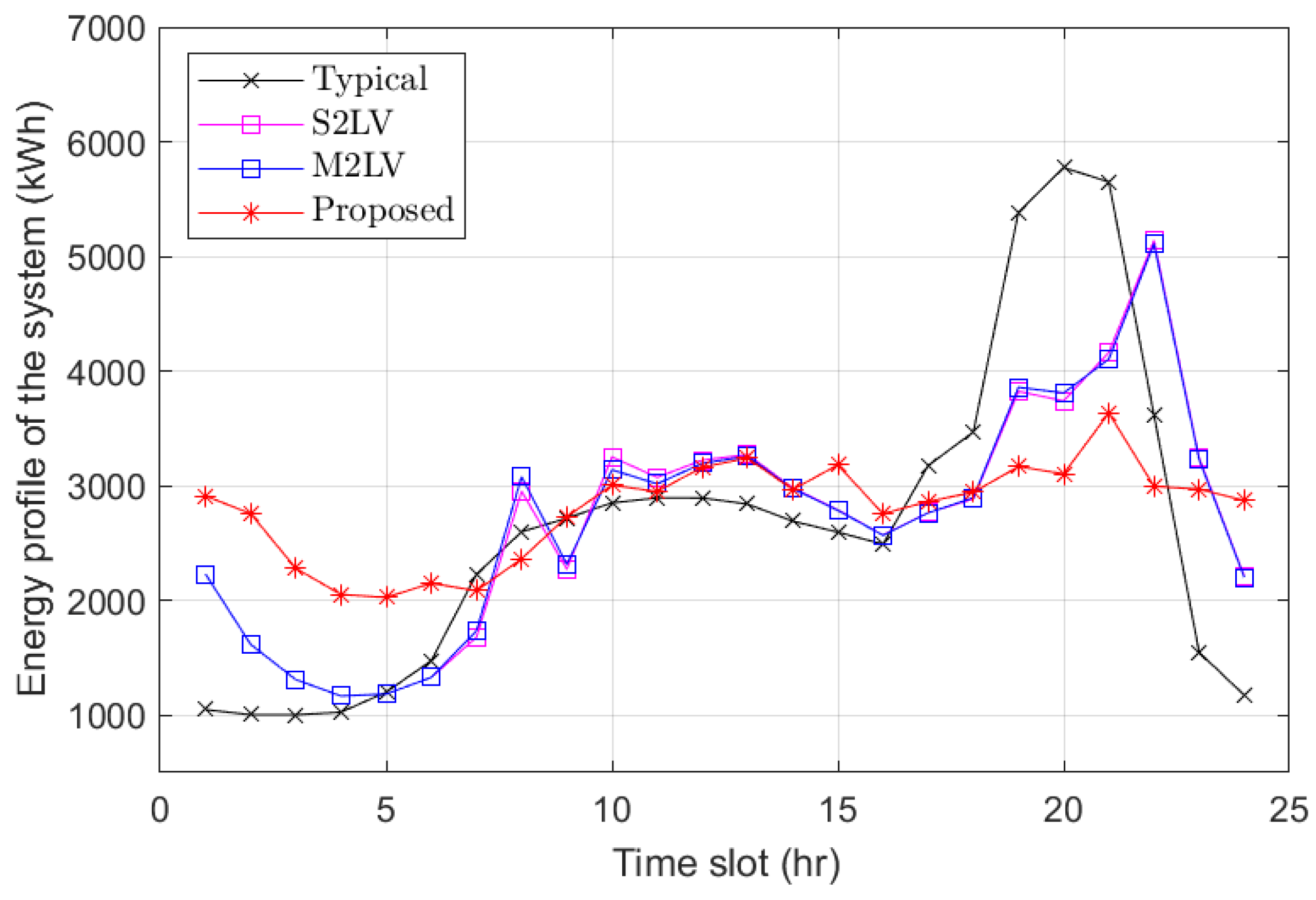
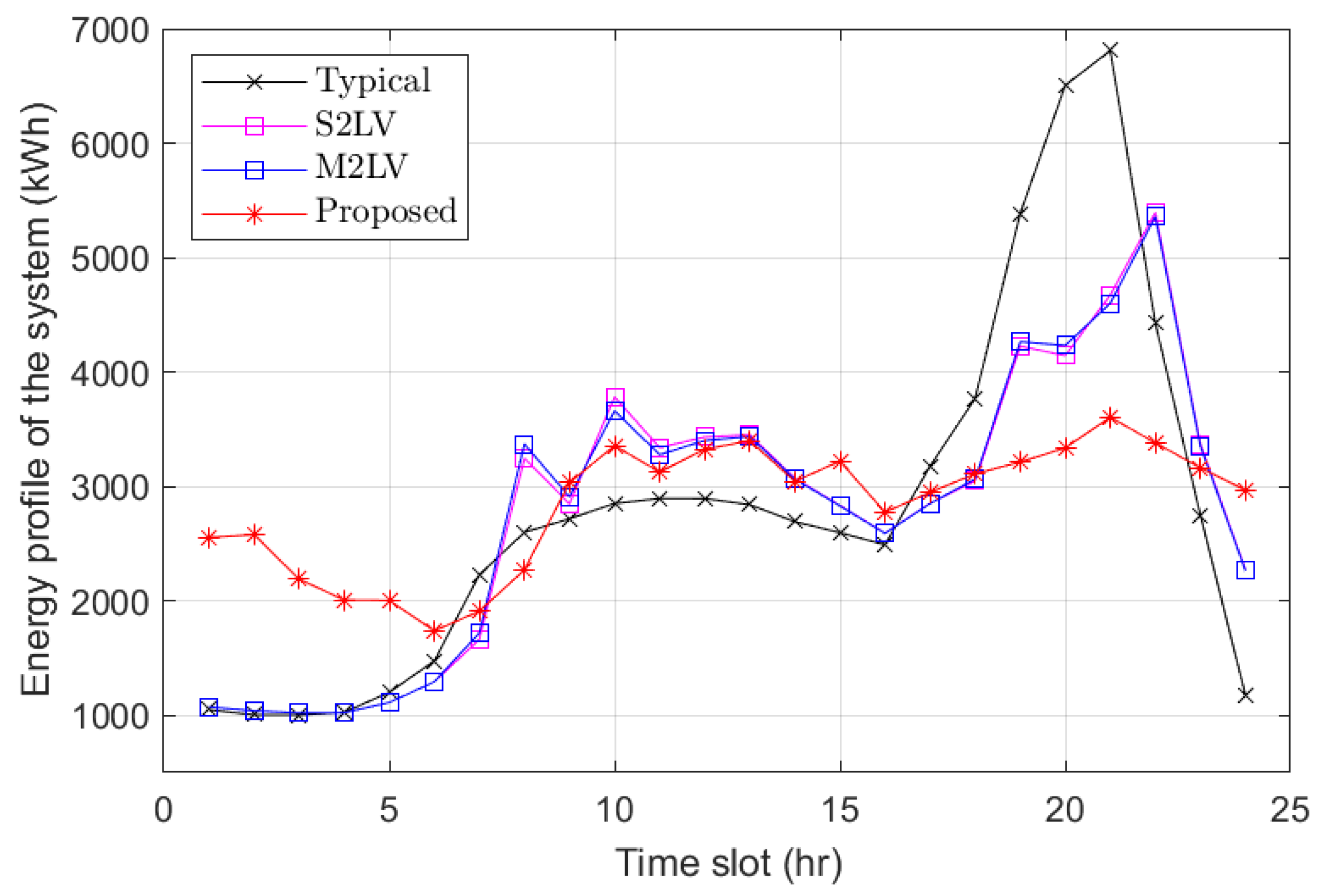

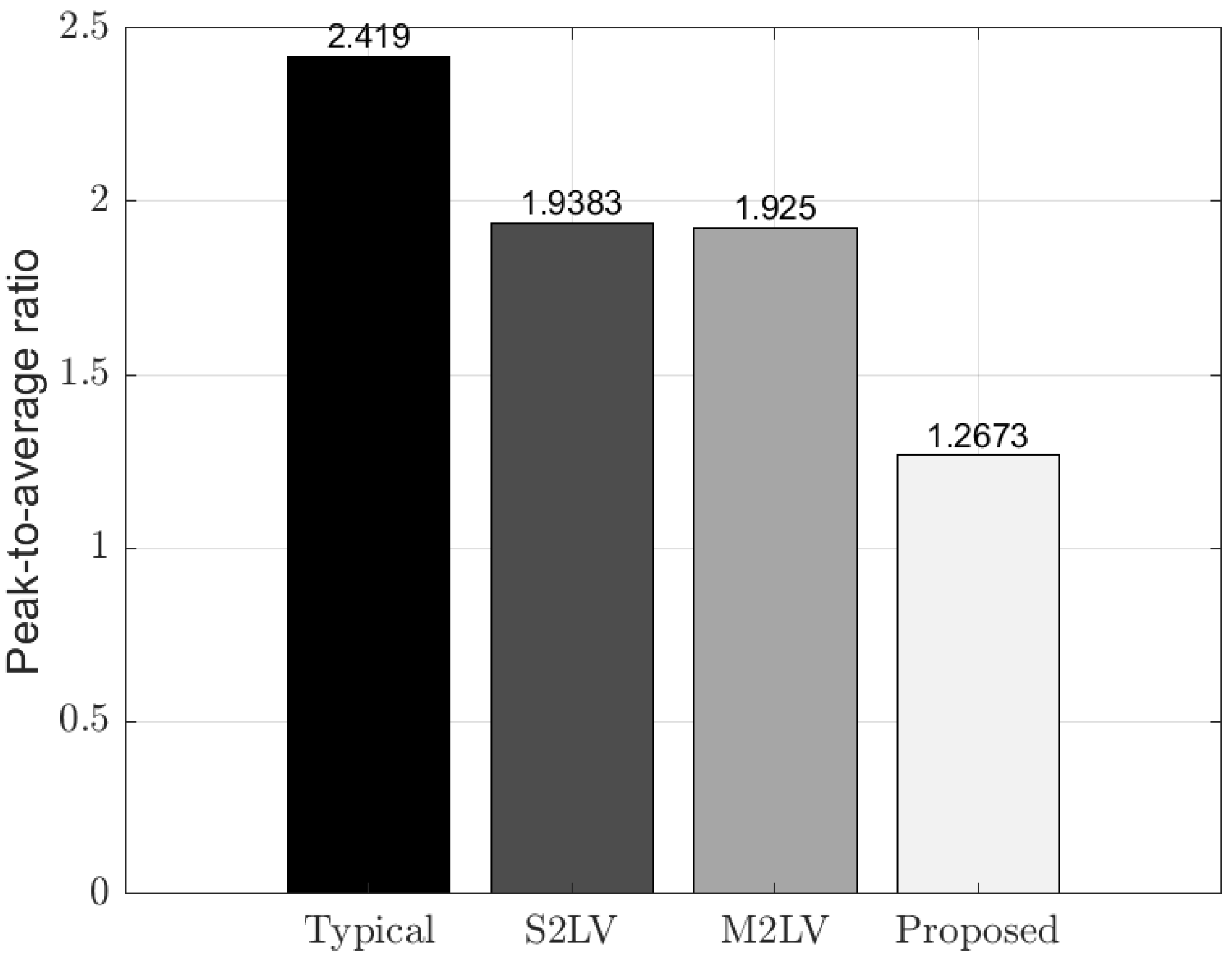

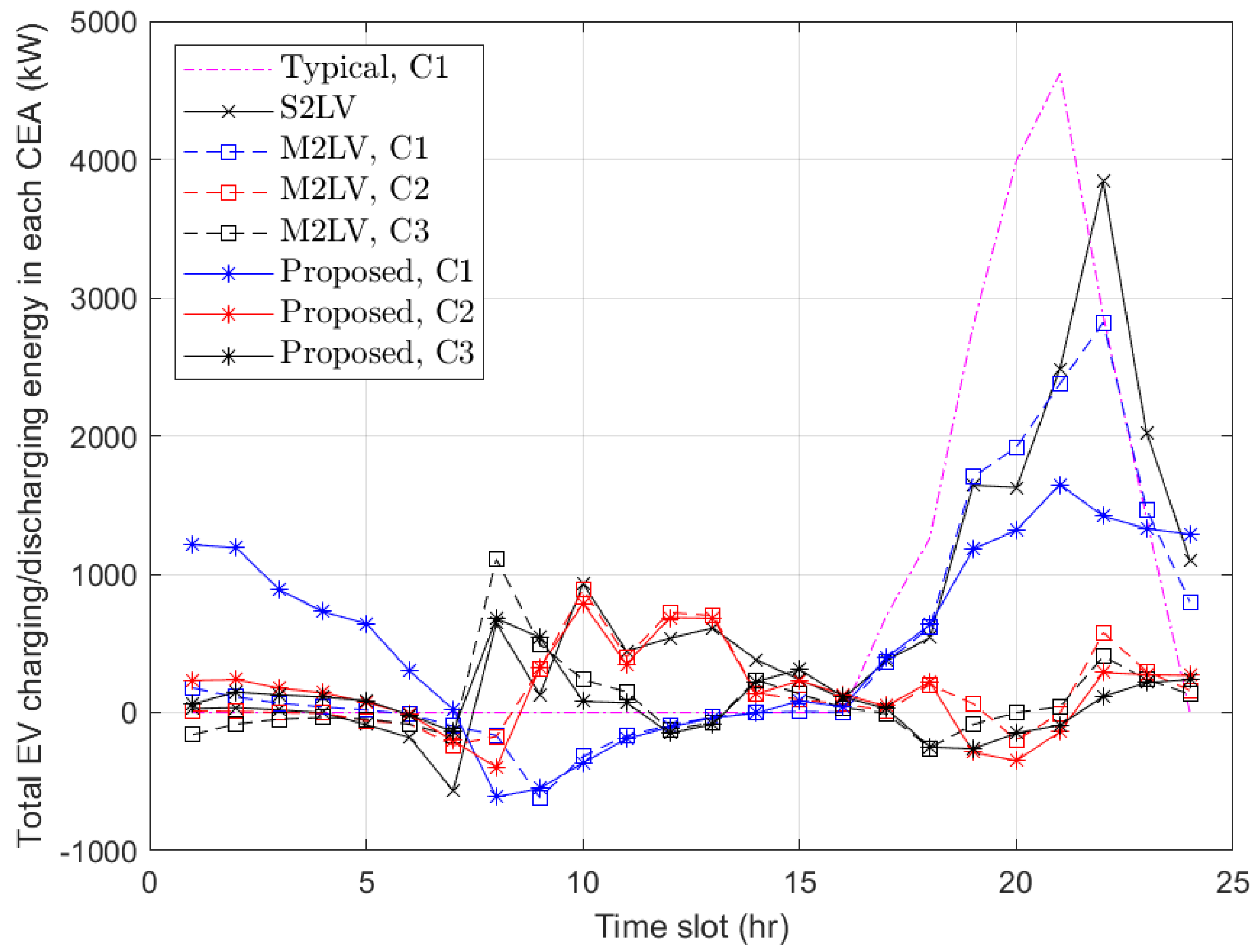
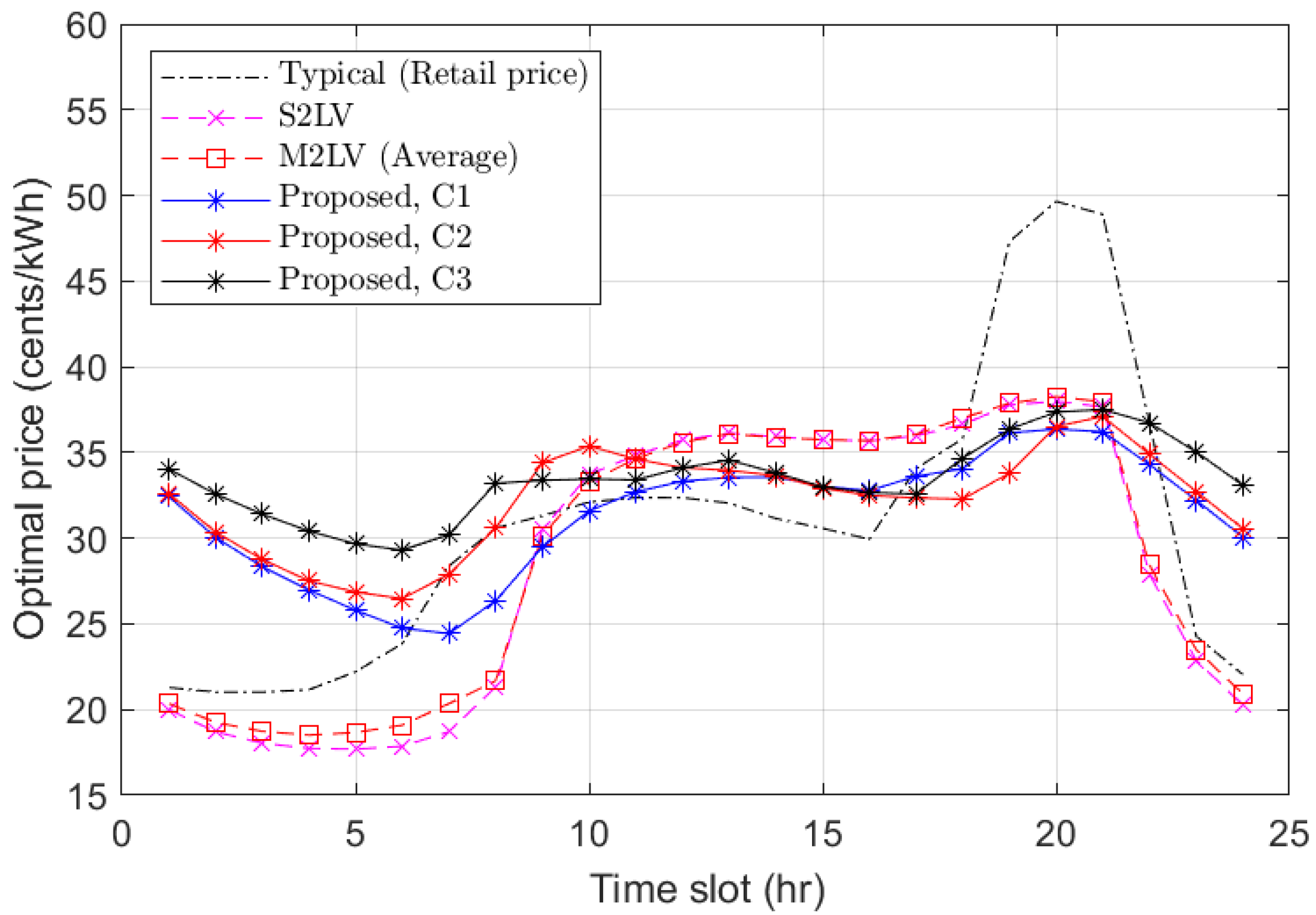



| Reference | Proposed Solution | Method | Communities | RE/Loads/EVs | Results |
|---|---|---|---|---|---|
| [8] | An energy-sharing model with price-based demand response | Supply-to-demand ratio | Single community | PV, residential loads | Save costs for PV prosumers while improving the sharing of PV energy |
| [9] | A new game-theoretic model for facilitating peer-to-peer energy trading among prosumers within a community. | 2-level Stackelberg game: seller prosumers, buyer prosumers | Single community | PV, residential loads, battery storage | Provide significant financial benefits where the cost are greatly reduced |
| [11] | A community-based energy trading model using blockchain | Non-cooperative game: suppliers, prosumers | Single community | PV, residential loads | Increase prosumers’ profits and significantly reduce peak energy demand |
| [16] | An energy dispatching model for a microgrid and prosumers possessing EVs | 2-level Stackelberg game: microgrid, prosumers | Single community | PV, prosumer loads, EVs | Increase in microgrid profits and reduction in prosumers’ costs |
| [19] | A novel power scheduling scheme for EV charging facility | 2-level Stackelberg game: charging facility, EVs | Single community | EVs | Improve the financial profit of EV users and the charging facility |
| [21] | An energy sharing framework for distributed network with a multi-energy-sharing region | 2-level Stackelberg game: energy sharing provider, prosumers | Multiple regions | PV, prosumer loads (No ESSs/EVs) | Increase the profit of players compared to the case without regional |
| [22] | A charging scheme for EVs in a smart communities integrated with RES | Non-cooperative game: microgids, EVs | Multiple microgrids | PV, buildings, EVs (only G2V) | Enhance the profit of EVs |
| [26] | An optimal V2G pricing strategy | 2-level Stackelberg game: aggregators, EVs | Multiple aggregators | EVs (only V2G) | Enhance the benefits for EV users while considering their satisfaction and inconvenience |
| This work | A hierarchical multi-communities energy sharing management framework in smart grid | Three-level Stackelberg game involving prosumers (EVs), a set of single communities, and multi-communities levels | Multiple communities (EVs are movable to different communities) | PV, buildings, EVs (both G2V and V2G) | Win-Win situation for every entity, reduce cost, lower peak energy, fill valleys, and decrease PAR |
| Period | EV1 | EV2 | EV3 | EV4 | EV5 | EV6 | EV7 | EV8 | EV9 | EV10 |
|---|---|---|---|---|---|---|---|---|---|---|
| 1 | ||||||||||
| 2 | ||||||||||
| 3 | ||||||||||
| 4 | ||||||||||
| 5 | ||||||||||
| 6 | ||||||||||
| 7 | 30 C1,3 | 40 C1,3 | 50 C1,3 | |||||||
| 8 | 30 C1,3 | 40 C1,3 | 20 C1,3 | 30 C1,2 | 60 C1,2 | |||||
| 9 | 40 C1,2 | 50 C1,2 | ||||||||
| 10 | ||||||||||
| 11 | ||||||||||
| 12 | 10 C3,2,3 | 10 C3,2,3 | 5 C3,2 | |||||||
| 13 | 10 C3,2,3 | 10 C3,2,3 | 5 C2,3 | |||||||
| 14 | ||||||||||
| 15 | ||||||||||
| 16 | 30 C3,1 | |||||||||
| 17 | 40 C3,1 | |||||||||
| 18 | 50 C3,1 | 30 C3,1 | 40 C3,1 | 5 C3,2 | ||||||
| 19 | 30 C2,1 | 60 C2,1 | ||||||||
| 20 | 20 C2,1 | 40 C2,1 | 50 C2,1 | |||||||
| 21 | ||||||||||
| 22 | ||||||||||
| 23 | ||||||||||
| 24 |
Disclaimer/Publisher’s Note: The statements, opinions and data contained in all publications are solely those of the individual author(s) and contributor(s) and not of MDPI and/or the editor(s). MDPI and/or the editor(s) disclaim responsibility for any injury to people or property resulting from any ideas, methods, instructions or products referred to in the content. |
© 2025 by the authors. Licensee MDPI, Basel, Switzerland. This article is an open access article distributed under the terms and conditions of the Creative Commons Attribution (CC BY) license (https://creativecommons.org/licenses/by/4.0/).
Share and Cite
Khwanrit, R.; Javaid, S.; Lim, Y.; Charoenlarpnopparut, C.; Tan, Y. Hierarchical Multi-Communities Energy Sharing Management with Electric Vehicle Integration. Energies 2025, 18, 393. https://doi.org/10.3390/en18020393
Khwanrit R, Javaid S, Lim Y, Charoenlarpnopparut C, Tan Y. Hierarchical Multi-Communities Energy Sharing Management with Electric Vehicle Integration. Energies. 2025; 18(2):393. https://doi.org/10.3390/en18020393
Chicago/Turabian StyleKhwanrit, Ruengwit, Saher Javaid, Yuto Lim, Chalie Charoenlarpnopparut, and Yasuo Tan. 2025. "Hierarchical Multi-Communities Energy Sharing Management with Electric Vehicle Integration" Energies 18, no. 2: 393. https://doi.org/10.3390/en18020393
APA StyleKhwanrit, R., Javaid, S., Lim, Y., Charoenlarpnopparut, C., & Tan, Y. (2025). Hierarchical Multi-Communities Energy Sharing Management with Electric Vehicle Integration. Energies, 18(2), 393. https://doi.org/10.3390/en18020393








